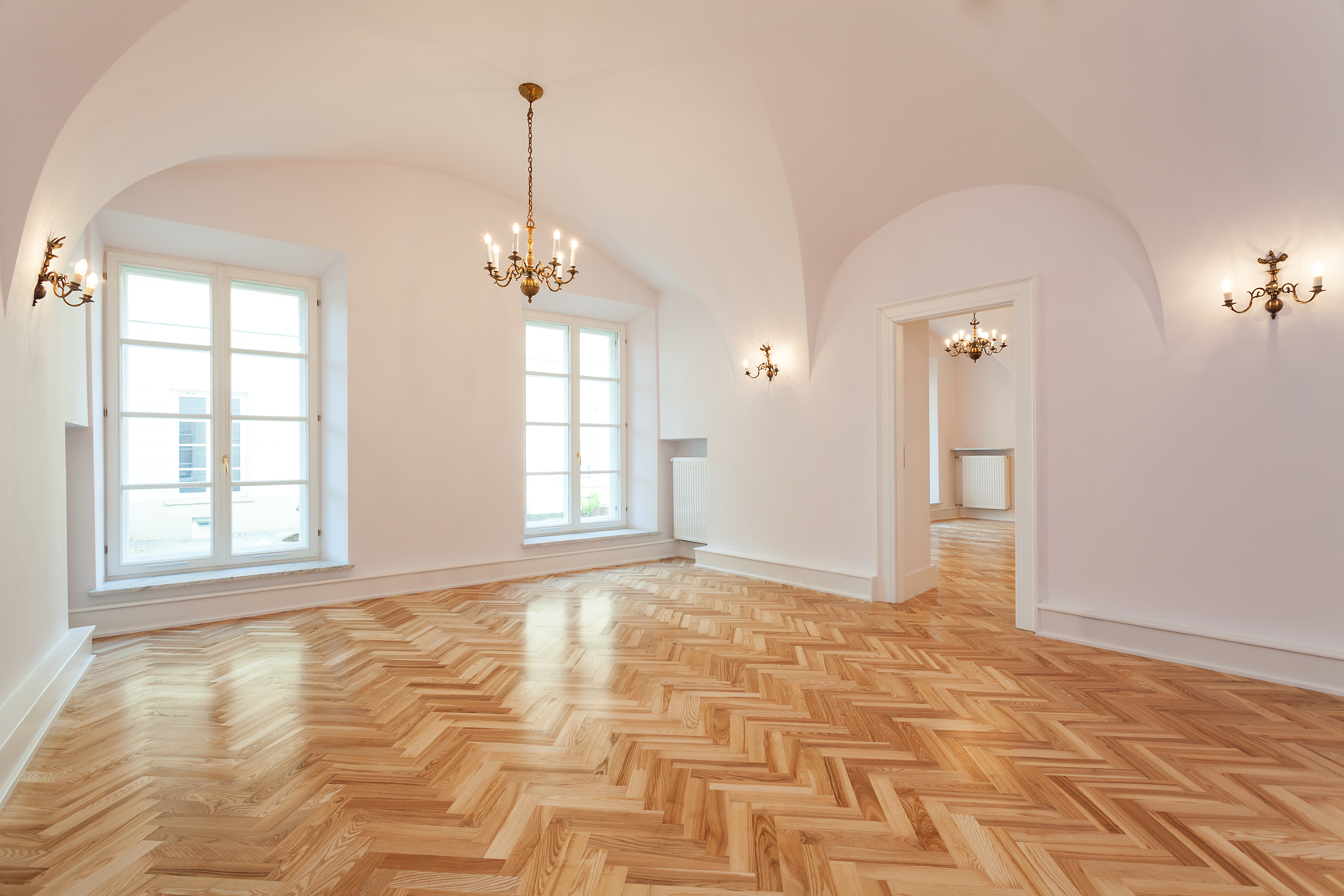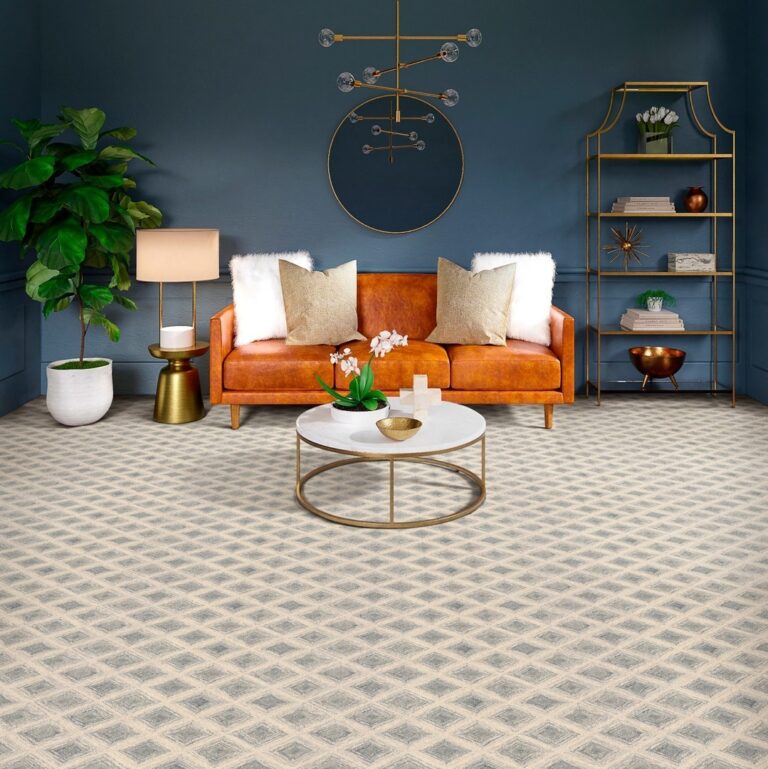Installing a new LVP (Luxury Vinyl Plank) flooring in a herringbone pattern is an easy DIY project that can upgrade the look of any room. Not only is herringbone LVP flooring a timeless and stylish look, but it’s also incredibly resilient, easy to clean, and can give the room a complete facelift in a short amount of time. In this guide, we’ll talk about why you should choose an LVP floor and then go through the step-by-step process of installing the herringbone floor in any room.
What Is a Herringbone LVP Floor?
By now you’ve likely heard the terms LVP and herringbone, but what exactly do they mean? LVP stands for luxury vinyl plank flooring, a durable, waterproof, and low-maintenance flooring option that is quickly growing in popularity for both residential and commercial spaces. Luxury vinyl plank is designed to mimic the appearance of natural materials like wood or stone, while providing the durability and ease of maintenance that comes with vinyl flooring. The herringbone pattern, on the other hand, is a distinctive flooring layout characterized by its repeating V shapes.
With the combination of LVP and herringbone, you get a beautiful flooring option that combines the classic elegance of a herringbone pattern with the practical benefits of luxury vinyl plank flooring. By choosing a herringbone LVP floor, you can elevate your home’s style while still enjoying a durable, low-maintenance flooring option that’s suitable for any room, even high-moisture areas like bathrooms and kitchens.
Best Brands of 2024
LVP Flooring Benefits
LVP flooring, also known as luxury vinyl plank flooring, is rapidly becoming one of the most popular flooring options on the market. It’s a cost-effective alternative to hardwood and other expensive flooring materials. Not only is it cheaper, but it also offers better durability and a range of other benefits. In this article, we’ll discuss some of the benefits of LVP flooring.
Durability
LVP flooring is one of the most durable types of flooring available in the market. It’s resistant to scratches, stains, and moisture, making it a perfect flooring choice for high-traffic areas of your home. With LVP flooring, there’s no need to worry about spills, pet claws, or furniture scratches. LVP flooring is ideal for both residential and commercial properties.
Easy Maintenance
LVP flooring is effortless to maintain, requiring only basic cleaning procedures to keep it looking its best. Unlike hardwood flooring or carpet, LVP flooring doesn’t require sanding or resurfacing after a few years of use. All you need to do is sweep the floor regularly and use a damp mop to clean away any dirt or spills. LVP flooring is water-resistant, making it easy to clean up spills without worrying about damage.
Aesthetically Appealing
Traditionally, vinyl flooring was considered to be cheap and lacking in style. However, LVP flooring has changed that perception. LVP flooring mimics the natural look and texture of real wood or stone, making it a perfect flooring choice for modern homes. With LVP flooring, you can achieve the aesthetic appeal of hardwood flooring without the high cost and maintenance requirements of real wood.
Versatility
LVP flooring comes in a wide range of designs, colors, and sizes, allowing you to create a unique and distinctive flooring look. Whether you’re looking for a classic oak look, a contemporary slate finish, or a textured, matte finish, there’s an LVP flooring option available to match your interior design preferences. The versatility of LVP flooring allows you to create a seamless transition between different areas of your home.
Affordability
One of the most significant benefits of LVP flooring is its affordability. Compared to other flooring materials like hardwood or natural stone, LVP flooring is significantly cheaper. The lower cost of LVP flooring makes it a more practical choice for homeowners on a budget or those who want a cost-effective flooring option without sacrificing quality or style.
Comfort
LVP flooring is one of the most comfortable flooring options available. It has a cushioned backing that absorbs sounds and reduces noise levels, making it suitable for homes with multiple occupants. Additionally, the cushioned backing of LVP flooring provides a comfortable walking experience and reduces fatigue, making it ideal for home settings where occupants are on their feet for extended periods.
Resistant to Water and Humidity
LVP flooring is a perfect choice for areas of the home that experience high levels of humidity or water exposure such as bathrooms, laundry rooms, and basements. Unlike hardwood, which is sensitive to humid and damp conditions, LVP flooring is resistant to moisture and water, making it a more practical choice for moisture-prone areas of your home.
Easy Installation
LVP flooring is easy to install, making it a perfect DIY flooring option. Unlike hardwood, which requires professional installation, LVP flooring can be installed by homeowners without the need for professional help. The installation process of LVP flooring involves laying it down on a flat surface, aligning the planks, and clicking them into place. The easy installation process saves time, money, and effort and allows you to enjoy your new flooring in no time.
In conclusion, LVP flooring is a practical, cost-effective, and versatile option for homeowners seeking a stylish and durable flooring solution. Its water-resistant and easy-to-maintain properties make it a perfect flooring choice for high-traffic areas like the kitchen, living room, or dining room. Moreover, LVP flooring’s affordability, comfort, and environmental-friendliness make it a great option for those looking for a long-term flooring solution that won’t break the bank.
Tips for Installing for Herringbone LVP Floors
Installing herringbone LVP flooring can seem like a daunting task, but with the right tools and patience, it can be a DIY project that adds a beautiful, unique touch to your home. Follow these step-by-step instructions to ensure a successful herringbone LVP floor installation.
Step 1: Gather the Tools:
Gather all the necessary tools and materials, including the LVP planks, underlayment (if needed), a circular saw or vinyl plank cutter, measuring tape, a chalk line or a straight edge, and a rubber mallet. Make sure you have enough LVP planks to cover the entire floor area plus an additional 10% to account for waste due to cuts.
Step 2: Prepare the Subfloor
Properly prepare the subfloor by making sure it is clean, dry, and level. If installing LVP over a concrete subfloor, use a moisture barrier to prevent moisture-related issues. For a wooden subfloor, make sure there are no protruding nails or uneven spots.
Step 3: Plan Your Pattern:
Plan the layout of the herringbone pattern by finding the center of the room and marking it. From this point, lay out a few LVP planks in the herringbone pattern without securing them, ensuring that the pattern will fit evenly within the room. Adjust the pattern as necessary, but keep in mind that it’s common for there to be partial planks along the edges of the room.
Step 4: Layout Your Planks
Begin by laying the first plank with its shorter end aligned with the centerline of the room. Place the next plank at a right angle to the first, making sure the planks fit tightly and form a 90-degree angle. Continue this process, adding one plank at a time, until you create a “V” shape with the planks. This “V” will serve as the foundation for the herringbone pattern.
Using the foundation “V” as a guide, continue to lay the LVP planks in the herringbone pattern across the room. Be sure to make precise cuts when necessary, and use a rubber mallet to gently tap the planks together to ensure a tight fit. Remember to stagger the pattern at the seams for a more natural and cohesive appearance.
Step 5: Put the Room Back Together
Once all herringbone planks have been laid, install any necessary transition strips or baseboards to complete the project. With the flooring installed, you’re ready to enjoy your beautiful new herringbone LVP floor! If you’re unsure whether you should install a herringbone pattern yourself, consider consulting a professional.
In conclusion, installing herringbone LVP flooring is a great DIY project that can transform the look of any room. Luxury vinyl plank flooring is a durable and low-maintenance option that is rapidly growing in popularity, and the herringbone pattern adds a distinctive and timeless touch to your home. With the right tools and careful planning, anyone can install herringbone LVP flooring on their own. The benefits of LVP flooring are numerous and include its affordability, durability, and versatility. LVP flooring can mimic the natural look of wood or stone while being resistant to scratches, stains, and moisture. It’s also comfortable, easy to maintain, and a practical choice for moisture-prone areas of the home like bathrooms and basements.
If you’re planning to install herringbone LVP flooring, it’s important to gather all the necessary tools and prepare your subfloor properly. Then, plan your pattern carefully by finding the center of the room and laying out a few planks as a guide. From there, lay the planks in a “V” shape and continue the herringbone pattern across the room, making precise cuts and using a rubber mallet to ensure a tight fit.
With your herringbone LVP floor installed, you can enjoy a stylish and durable flooring option that will elevate the look of your home for years to come.
About The Author

Courtney Daily
April 12, 2023
Courtney is a freelance writer who wears many other hats: kindergarten teacher by day, Broadway diva in the shower. She is a transplant Hoosier who originated in New England. When she isn't writing in her spare time, you will find her reading history books, arguing with her latest knitting project, or being beaten by her kids at most games.



